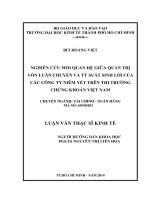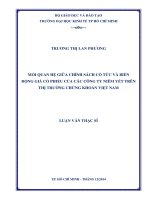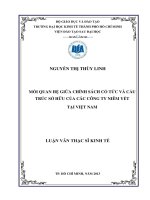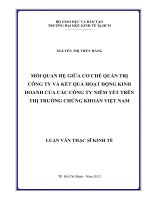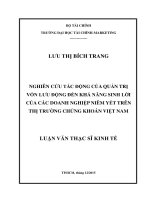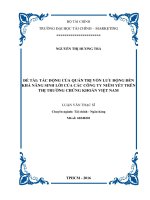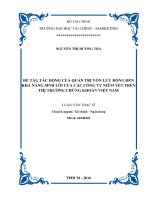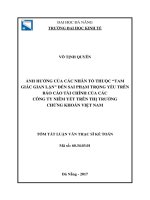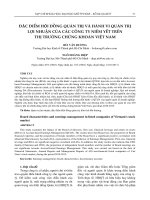Nghiên cứu mối quan hệ giữa thay đổi cổ tức và khả năng sinh lợi của các công ty niêm yết trên thị trường chứng khoán việt nam tt tiếng anh
Bạn đang xem bản rút gọn của tài liệu. Xem và tải ngay bản đầy đủ của tài liệu tại đây (184.15 KB, 12 trang )
1
2
INTRODUCTION
subsequent years, Kato et al. (2002) investigating the Japanese stock market,
Choi et al. (2011) researching on the Korean stock market also found a positive
relationship between dividend changes and changes in profits one year after the
dividend change, Chinpiao Liu and An-Sing Chen (2015) studying the Chinese
stock market showed that dividend changes is a sign of prospects for return on
equity.
On the other hand, many studies have found little or no correlation
between dividend changes and profitability of enterprises. Typical examples
include: DeAngelo (1996), Benartzi et al. (1997), Grullon et al. (2005), Lie
(2005) did not find a significant relationship between dividend changes and
changes in earnings, Jensen et al. (2010) proved that the profits of enterprises
will bounce back after reducing dividends.
In summary, there have been many different conclusions when predicting
the enterprises’ profitability based on information about dividend changes.
Moreover, these studies focused on changing of dividends in cash without
considering the possibility of an enterprise buying back shares during the year
of paying dividends in cash, because repurchasing shares is a form of profit
distribution among shareholders. In addition, many researchers have
demonstrated that ownership structure affects the dividend payment of listed
companies. Therefore, the correlation between dividend changes and
profitability may vary according to ownership structure. However, so far there
have been no studies clarifying dividend signaling in the form of ownership and
in the case of enterprises repurchasing shares in the market.
In Vietnam, many studies on dividends, but so far there has been no
research on the effect of dividend changes on the forecast of profitability of the
following years of listed companies on the stock market, which can provide
useful information for investors and business managers.
Based on the above reasoning and practice, the author has chosen the
topic: “The relationship between dividend changes and profitability of
listed companies on Vietnam stock market”
2. Research objectives
This study aims to investigate one-way relationship between dividend
1. Necessity of research topic
Regarding the analysis of common stocks, dividend is a topic of major
concern in corporate finance. According to Graham and Dodd (2017), the
dividend payout ratio and dividend payment history are factors involving in the
process of valuation of common stocks. Many domestic and foreign studies
analyzed the impact of dividends on corporate value, as well as on stock prices in
the market. These studies mainly analyzed annual dividend payout ratios.
Besides, some other researchers focused on analyzing the change in dividends of
enterprises. The signaling theory of dividends assumes that dividend changes
contain information about the profits and future profitability of enterprises,
managers use changes in dividend to convey information about future prospects
to investors. Many scholars around the world spent time studying and clarifying
this issue. However, so far the question of whether changes in dividend mean a
good signal about the future profitability of companies is still controversial.
Lintner (1956) stated that managers are willing to pay higher dividends
when their current profits are large enough to pay cash dividends. Bhattacharya
(1979), Miller and Rock (1985), John and Williams (1985) provided theoretical
models of dividend signaling. These models showed that when managers
forecast better results, they will send this signal to the market by paying
dividends.
In the world, there have been a number of studies analyzing the
correlation between changes in dividend and profitability of enterprises which
has becoming a topic attracting attention of many subjects. Empirical results
provide different conclusions, divided into 2 basic groups: The first group
supports the viewpoint that dividend changes reveal the future profitability of
enterprises; the second group does not support this view and believes that the
increases or decreases of dividend are not linked with changes in future
earnings. Studies in the first group include: Healy and Palepu (1988), Nissim
and Ziv (2001) implemented in the US Stock Exchange showing that dividend
changes are positively correlated with changes in profitability in two
3
4
changes and profitability of the next 2 years of listed companies on Vietnam
stock market, thereby finding empirical evidence on dividend signaling on
Vietnam Stock Market. Specific objectives include:
- Evaluating current status of dividends, dividend changes and profitability
of listed companies on Vietnam stock market in the period 2008-2017.
- Examining one-way relationship between dividend changes and
profitability in 2 subsequent years of listed companies on Vietnam stock
market.
- Examining one-way relationship between dividend changes and
profitability in 2 subsequent years of state-owned companies and privately
owned companies.
- Examining one-way relationship between dividend changes and
profitability in 2 subsequent years of companies repurchasing stocks in the
market during the dividend change year
Based on the above objectives, the research develops the following research
questions:
(1) What is the actual situation of dividends, dividend changes and
profitability of listed companies on Vietnam stock market in the period 20082017?
(2) Are dividend changes a signal of profitability for the following years of
listed companies on Vietnam stock market?
(3) How does the one-way relationship between dividend changes and future
profitability vary between the state-owned companies and privately owned
companies
(4) How does the one-way relationship between dividend changes and future
profitability vary between companies repurchasing stocks and companies not
repurchasing stocks?
(5) What are the recommendations for investors, business managers and state
agencies based on the research results?
3. Research subjects and scope
3.1. Research subjects
The research subjects are dividend changes and one-way relationship
between dividend changes and profitability in 2 years subsequent to the
dividend change year (year 1 and year 2) of listed companies on Vietnam stock
market. However, this research only focuses on companies paying dividends in
cash.
3.2. Research scope
- Space: Non-financial companies listed on Ho Chi Minh Stock
Exchange and Hanoi Stock Exchange
- Time: The period 2008-2017.
4. Contributions of the research
Theoretical contributions
Based on the signaling theory in general and dividend signaling theory in
particular, the thesis systematized the theoretical basis of one-way relationship
between dividend changes and future profitability; analyzed and clarified the
difference between the developed stock market and the frontier stock market.
Whereby, the thesis has established and tested the hypothesis of dividend
signaling on the frontier stock market in Vietnam. The empirical evidence
obtained from the study is a significant source of information in terms of
dividend signaling theory that other developing countries can refer to.
(i) Is there a relationship between dividend changes and future profitability
of firms?
(ii) Are there any differences in the relationship between dividend changes
and profitability of state-owned companies and privately owned companies?
(iii) Does repurchasing shares in the market in the dividend change year
reduce the content of information from dividend signaling?
Moreover, the thesis has added 3 control variables into the model to test
the above relationship which are all statistically significant. The 3 variables are:
Enterprise size, investment opportunities and growth rate. Finally, the thesis
also contributed to providing evidence to support the signaling theory of
dividend in emerging markets like Vietnam.
Practical contributions
The research sample includes: 657 observations of dividend increases, 893
observations of dividend decreases and 643 observations of no-change
5
6
dividends of non-financial companies listed on Ho Chi Minh Stock Exchange
and Hanoi Stock Exchange in the period 2008-2017. The thesis has provided
convincing evidence of the causal relationship between dividend changes and
profitability in 2 subsequent years in Vietnam stock market – which has not
been proved by any prior research. In general, on Vietnam stock market,
dividend increases imply that the profits in one following year of the company
will increase, dividend decreases indicate that the profits in one following year
of the company will decrease, but the decreases in profits will be higher than
the increases in profits. However, the signaling theory is not completely
confirmed with enterprises of different sectors, enterprises categorized by stateowned and privately owned factors, or enterprises that buy back/not buy back
shares in the dividend change year. Specifically: State-owned enterprises do not
support signaling theory of dividends; with companies changing dividends at
the same time repurchasing stocks in the market, research does not find any
evidence of the relationship between dividend changes and future profitability.
These findings are of practical significance to investors when predicting
the profitability of enterprises in 2 subsequent years based on signs of dividend
changes. In addition, research is basis for enterprises to provide more
reasonable dividend policies, on the basis of balancing the purpose of business
development and the psychology of shareholders; as well as proposing some
recommendations for the State management agencies in issuing regulations on
information disclosures of dividends.
5. Research structure
Apart from the table of contents, the list of abbreviations, the list of tables,
preface, the list of references and appendices, the thesis has 5 chapters.
CHAPTER 1:
THEORETICAL FOUNDATION AND LITERATURE REVIEW ON
THE RELATIONSHIP BETWEEN DIVIDEND CHANGES AND
PROFITABILITY OF ENTERPRISES
1.1. Theoretical foundation on the relationship between dividend changes
and profitability of enterprises
1.1.1. Dividend
1.1.1.1. Definition of dividend, dividend policy
Dividend is the share in the profits after tax of a joint-stock company
divided to the current shareholders.
Dividend policy is the policy related to decisions on distribution of profits
after taxes for existing shareholders, form and dividend payout ratio.
1.1.1.2. Forms of dividend payment of joint-stock companies
Dividends can be paid in cash, by shares of the company or by other
assets as stipulated in the company's Charter.
1.1.1.3. Dividend payment procedures
1.1.1.4. Models of paying dividends of joint-stock companies
1.1.1.5. Dividend ratios
Dividend per Share (DPS)
DPS = Total dividends paid/Number of shares
Dividend payout ratio
Dividend payout ratio = Dividends per share/ Earnings per share
Dividend Yield
Dividend yield = Dividends per share / Market value per share
1.1.2. Definition of profitability and profitability ratios
1.1.2.1. Definition of profitability
Profitability reflects the amount of profits that an enterprise receives per
unit of cost, per unit of input or per unit of revenue.
1.1.2.2. Profitability ratios
- Return on Sales (ROS)
- Return on Assets (ROA)
- Return on Equity (ROE)
1.1.3. Theories on the relationship between dividend changes and profitability
of enterprises
1.1.3.1. Information asymmetry and signaling theory
According to Kyle (1985), information asymmetry on the stock market
occurs when one or more investors have their own information. Kim and
Verrecchia (1994) provided that information asymmetry occurs when a group
of investors has more public information about a company. Signaling theory is
7
8
designed to reduce information asymmetry between senders and recipients of
information.
1.1.3.2. Signaling theory of dividends
The signaling theory of dividends supposes that profit distributions such
as dividends contain good signals about an enterprise. Based on dividend
signaling, investors can get information about the prospects of enterprises
through dividend decisions. Specifically, dividend increases is a good signal of
the prospects of the company, the share price will increase and vice versa.
The signaling theory and especially the signaling theory of dividends are
the foundation for the author to study the one-way relationship between
dividend changes and profitability in 2 subsequent years of enterprises on
Vietnam stock market. .
1.1.3.3. Other theories related to dividends
- Theory of Miller and Modiglani (M&M)
- The free cash flow theory
- The agency costs theory
- The risk averse theory
- The life circle theory of dividends
1.2. Literature review
1.2.1. Literature review of studies in the world
Table 1.1: The summary of empirical research results between dividend
changes and profitability in some countries in the world
Researchers
Results
Watt (1973)
Weak correlation is found
Aharony and - Positive correlation is found with increases in
Swary (1980)
dividends
- Negative correlation is found with decreases in
dividends
Healy
and Earnings increase (decrease) at least one year after the
Palepu (1988)
first dividend payment (not paying dividend)
DeAngelo et - If profits and dividend decrease, profits in 2 subsequent
Researchers
al. (1992)
Benartzi et al.
(1997)
Fukada (2000)
Nissim and Ziv
(2001)
Grullon et al.
(2005)
Harada
and
Nguyen (2005)
Lie (2005)
Results
years will decrease
- If profits decrease but dividend does not decrease,
profits in 2 subsequent years will increase
- An increase in dividend does not predict profits of the
following year
- If dividends decrease, profits of the following year will
increase
- If dividend increases, profits of the following years will
decrease
- If dividend decreases, profits of the following years will
increase
Positive correlation is found between dividend changes
and changes in profits 2 years after
- Positive correlation is found between dividend increases
and changes in profits 2 years after
- No correlation is found between dividend decreases and
changes in profits 2 years after
- Non-linear model does not support signaling theory
Positive correlation is found between dividend changes
and changes in profits in the following years
- If dividend is not paid, profits decrease next quarter, but
increase again in the following quarters
- If dividend decreases, profits do not decrease
If dividend decreases, ROA increases after one year
Jensen et al.
(2010)
Choi et al. - Positive correlation is found between dividend decreases
(2011)
and changes in profits one year after
- No correlation is found with dividend increases
- Non-linear model does not support signaling theory
Reza et al. - Positive correlation is found between dividend
9
Researchers
(2014)
10
Results
increases and profitability in 2 subsequent years
- Positive correlation is found between dividend
decreases and profitability in one subsequent year and
negative correlation is found between dividend decreases
and profitability in 2 subsequent years
Fairchild et al. - Negative correlation is found between dividend
(2014)
decreases and changes in profits in one following year
- Negative correlation is found between dividend
decreases and changes in ROA in 2 subsequent years
Liu and Chen - No correlation is found between dividend changes and
(2015)
changes in ROE
- Negative correlation is found between dividend
changes and changes in ROA in one subsequent year
Kadioglu and No support is found for signaling theory of dividends
Ocal (2016)
Deng et al. Positive correlation is found between dividend rates and
(2017)
profits in one subsequent year
Source: compilation of the author
1.2.2. Literature review of studies in Vietnam
In Vietnam, there have been many studies on dividends. However, these
studies focused on dividend rates and dividend policy. So far, there has been no
research on the dividend changes of enterprises, especially the topic of the
relationship between dividend changes and profitability of enterprises or
verification of signaling theory of dividends on Vietnam stock market. The
research in Vietnam on the topic of dividends mainly focused on the following
aspects:
Dividend policy
Impact of dividends on stock prices
Impact of dividends on operational efficiency of enterprises
Impact of ownership structure on dividend policy
CHAPTER 2:
CURRENT SITUATION OF DIVIDENDS, DIVIDEND CHANGES AND
PROFITABILITY OF LISTED ENTERPRISES ON
VIETNAM STOCK MARKET
2.1. Listed enterprises on Vietnam stock market
2.1.1. Number of listed joint-stock companies
By the end of 2017, there were 713 companies listed on HOSE and HNX.
2.1.2. Sector classification of listed joint-stock companies
In this study, the sector classification in accordance with ICB level 1 of
Stoxplus is applied with 10 sectors
2.2. Current situation of dividends of listed enterprises on Vietnam stock
market
2.2.1. Dividend payment
Forms of dividend payment
The statistics of companies paying dividends on Vietnam stock market in the
period from 2008 to 2016 showed that paying dividends in cash is the most
comment form of payment compared to stock dividends
The number of companies paying dividends in cash by ownership
structures
In 2008, the proportion of state-owned enterprises paying cash dividends
accounted for 81.58%, while privately owned enterprises paying cash dividends
only accounted for 18.42%. The proportion of cash dividends of state-owned
enterprises tends to decrease, whereas the proportion of cash dividends paid by
privately owned enterprises tends to increase rapidly.
The number of companies paying dividends in cash by sectors
The industrials has the largest number of companies paying cash
dividends, followed by consumer goods and raw materials, especially, oil and
gas and banking sectors have very small number of companies paying cash
dividends.
2.2.2. Dividend rates
The annual dividend rates of enterprises listed on Vietnam stock market
in the period of 2008-2016 are mainly from 1,000-2,000 VND/share. From
11
12
2013 to 2016 the proportion of companies paying dividends below 1,000
VND/share increased compared to previous years. The average dividend rates
of companies listed on Vietnam stock market from 2008 to 2016 were larger
than 1,500 VND. The average dividend rate of privately owned enterprises is
usually higher than that of state-owned enterprises.
2.2.3. Summary of the current status of dividend payment of listed companies
on Vietnam stock market during the period from 2008 to 2016
Firstly, cash dividends always accounts for a larger proportion of stock
dividends.
Secondly, Companies which maintain annual dividend payment are often
large-scale companies with long operating time and stable growth.
Thirdly, consumer goods is the sector that maintains high and relatively
stable dividends, banking is the sector with the largest dividend fluctuation.
Fourthly, Enterprises in the real estate sector often choose to pay stock
dividends.
2.3. Current situation of profits and profitability of listed companies on
Vietnam stock market during the period from 2008 to 2017
2.3.1. Profits of listed companies on Vietnam stock market
In 2008, the average profit was the lowest in the period 2008-2017, reaching
64.9 billion VND. In 2009 and 2010, the business situation of enterprises has
improved. In 2011 and 2012, Vietnamese enterprises fell into difficulties. From
2013 to 2017, the business situation of enterprises had many changes, profits
increased again. In 2017, the average profits was the highest in the period 20082017, reaching VND 230 billion, increased 23% compared to 2016.
2.3.2. ROA and ROE of listed companies on Vietnam stock market during the
period from 2008 to 2017
In 2009, ROA and ROE were the highest during the period from 20082017 reaching 9.73% and 21.73%. Since 2010, the performance of listed
companies on Vietnam stock market began to decline gradually and fall to a
lowest level in 2013. ROA and ROE of enterprises changed according to
ownership structures.
2.3.3. Summary of the actual situation of the profits and profitability of listed
companies on Vietnam stock market in the period 2008 - 2017
Firstly, profits and profitability of Vietnamese enterprises in the period
2008-2017 fluctuated considerably.
Secondly, the average profit of state-owned enterprises was lower than
that of privately owned enterprises.
Thirdly, the profitability of Vietnamese enterprises in the period 20082017 reached the highest value in 2009 and began to decline since 2010, and
reached the lowest values in 2012 and 2013.
2.4. Actual situation of dividend changes and changes in profitability of
listed joint-stock companies on Vietnam stock market
2.4.1. Actual situation of dividend changes of listed joint-stock companies on
Vietnam stock market
In the period 2008 - 2016, out of 2700 observations: 844 cases
experiencing dividend increases (accounted for 31.26%), 1133 cases
experiencing dividend decreases (accounted for 41.96%) and 723 cases
experiencing no-change dividends (accounted for 26.78%). The results show
that the proportion of enterprises listed on the stock market in Vietnam
experiencing annual dividend changes (increases or decreases) is relatively
high, accounting for 73.22%.
2.4.2. Actual situation of changes in profits and profitability of listed jointstock companies on Vietnam stock market
Enterprises with dividend increases or no-change dividends often have
increases in profits in the dividend change year and 2 subsequent years, but
with enterprises reducing dividends, profits decrease in the year of decreasing
dividends and one year after. However, ROA and ROE of companies that
increase dividends usually only increase in year 0, but tend to decrease in 2
subsequent years. In contrast, with firms reducing dividends, ROA and ROE
tends to reduce in years 0 and 1, but increase again in 2 subsequent years.
CHAPTER 3:
METHODOLOGY
3.1. Research gaps
13
14
Firstly, there has been no research on this topic conducted in frontier
markets. In Vietnam, there have been many research projects on dividends, but
so far there has been no study evaluating the relationship between dividend
changes and future profitability of listed companies on the stock market. .
Secondly, here has been no research comparing the relationship between
dividend changes and future profitability of 2 groups of enterprises: stateowned enterprises and privately owned enterprises.
Thirdly, there has been no research examining the relationship between
dividend changes and future profitability in case companies repurchasing shares
at the year of changing dividend, thereby more accurately evaluating the
content of the signaling theory of dividends.
3.2. Experimental research models on the relationship between dividend
changes and profitability of enterprises
3.2.1. The model of Benartzi et al. (1997)
3.2.2. The model of Nissim & Ziv (2001)
3.2.3. The model of Grullon et al. (2005)
3.3. Research hypotheses and research model on the relationship between
dividend changes and profitability of enterprises listed on Vietnam stock
market.
3.3.1. Research hypotheses
Hypothesis H1: In Vietnam, dividend changes are positively correlated (+)
with the profitability in one subsequent year (T = 1) of listed companies on the
stock market.
Hypothesis H2: In Vietnam, a decrease in dividend is negatively correlated (-)
with the profitability in two subsequent years (T=2) of listed companies on the stock
market.
Hypothesis H3: In Vietnam, dividend changes along with not repurchasing
shares in the year of changing dividend is positively correlated (+) with the future
profitability of listed companies on the stock market.
Hypothesis H4: In Vietnam, dividend changes along with repurchasing
shares in the year of changing dividend will decrease information on profitability
of listed companies on the stock market.
3.3.2. Research model
In order to test the research hypotheses above, two models of Nissim and
Ziv (2001) are applied:
MH1: (Et - Et-1)/B-1 = α0 + α1 DIV0 + α2ROEt-1 + εt
MH2: (Et - Et-1)/B-1 = α0 + α1DPC. DIV0 + α2DNC. DIV0 + α3ROEt-1
+ α4(E0 – E-1)/B-1 + εt
Then, the model proposed by Choi et al. (2011) is applied:
MH3: (Et - Et-1)/B-1 = α0 + α1 DIV0 + α2ROEt-1+ α3 DIV-1 + α4ROEt-2
+ α5(E0 – E-1)/B-1 + εt
Next, nonlinear model of Grullon et al. (2005) is applied:
MH4: (Et - Et-1)/B-1 = α0 + α1DPC. DIV0 + α2DNC. DIV0 +
+ (β1DFE0+β2NDFED0.DFE0+β3NDFED0.DFE02+β4PDFED0.DFE02)
+ (λ1CE0+ λ2NCED0.CE0+ λ3NCED0.CE02 + λ4PCED0.CE02) + εt
Finally, the regression model of Nissim and Ziv (2001) is extended by
adding control variables in the model including: Enterprise size (SIZE), investment
opportunities (MTB) and growth rate (GROW).
MH5: (Et - Et-1)/B-1 = α0 + α1DPC. DIV0 + α2DNC. DIV0 + α3ROEt-1
+ α4(E0 – E-1)/B-1 + α5SIZE0+ α6MTB0 + α7GROW0 + εt
In which:
t = 0 is the dividend change year, the research tests with t =1 and t =2
DIV0: the dividend change in year 0
Et: Earnings in year t after dividend change of enterprise i
Et-1: Earnings one year before year t of enterprise i
B-1: Book value of equity one year before the dividend change year
ROEt-1: Return on equity one year before year t
DPC: A dummy variable which equals 1 if dividend increases ( DIV0>0)
and equals 0 in other cases.
DNC: A dummy variable which equals 1 if dividend decreases
( DIV0>0) and equals 0 in other cases.
E0: Earnings of enterprise i in the dividend change year (year 0)
E-1: Earnings of enterprise i one year before the dividend change year
DFE0 = ROEi,0 – E[ROEi,0 ], with E[ROEi,0] is the expected value of
15
16
ROEi,0
NDFED0 (PDFED0) is a dummy variable which equals 1 if DFE0 is
negative (positive) and equals 0 in other cases
CE0 = (E0 – E-1)/B-1
NCED0 (PCED0) is a dummy variable which equals 1 if CE0 is negative
(positive) and equals 0 in other cases
SIZE0: enterprise size in the dividend change year
MTB0: Market value of share/book value of share in the dividend change
year
GROW0: growth rate of enterprise in the dividend change year
After conducting the above 5 research models, the Robustness check was
conducted with the dependent variable of change of return on assets (ROAt –
ROAt-1). Control variables include ROEt-1 and the lagged dependent variable
(E0 – E-1)/B-1 in the above models is replaced by ROAt-1 and (ROA0 – ROA-1).
3.4. Research data
The sample includes non-financial companies listed on Ho Chi Minh
City Stock Exchange and Hanoi Stock Exchange in the period 2008-2017.
Data on dividends and financial ratios of non-financial companies listed on the
Vietnam stock market are taken from StoxPlus data.
After collecting data on dividends and financial indicators of enterprises
in the research sample, the author calculated the value of dependent variables
(Et - Et-1)/B-1 and (ROAt – ROAt-1) with t=1 and t=2, independent variable is the
annual dividend change DIV0: DIV0 = (DIVi,0– DIVi,-1)/DIVi,-1
Finally, research data includes 657 observations of dividend increases,
893 observations of dividend decreases and 643 no-change observations.
3.5. Methodology
In order to study the relationship between dividend changes and future
profitability of enterprises on Vietnam stock market, both qualitative research
and quantitative research methods are used. Qualitative research is conducted
by evaluating the correlation between dividend changes and profitability
changes in the dividend change year (year 0) and the two subsequent years
(year 1 and year 2) of companies listed on Vietnam stock market. Quantitative
research is performed with 5 regression models on the relationship between
dividend changes and future profitability, Fixed Effects Model (FEM) and
Random Effects Model (REM) based on panel data, with statistical software
STATA14. However, Hausman test results show that FEM is more suitable
than REM. After that, the author detects autocorrelation, heteroscedastic errors
and multicollinearity in the models. The results show that both autocorrelation,
heteroscedastic errors present in the models. The cluster command in stata is
used to overcome the autocorrelation and heteroscedasticity in the FEM.
CHAPTER 4
TEST RESULTS OF THE RELATIONSHIP BETWEEN
DIVIDEND CHANGES AND PROFITABILITY OF THE LISTED
COMPANIES ON VIETNAM STOCK MARKET
4.1. Descriptive Statistics
In the case of dividend increases, the average growth rate of dividends is
65%, changes in profitability one year after dividend change have positive
values, but the profits in 2 subsequent years are negative values. In the case of
dividend decreases, the average reduction rate of dividend is 52%, profit
changes in one year after the dividend change have negative values, profit
changes in 2 years subsequent to the dividend change. In the cases of no-change
dividends, profitability in 2 subsequent years has positive values. Thus, the
sample descriptive statistics have found evidence to support the signaling
theory of dividends. In addition, with enterprises increasing dividends, the
ratios: ROA, ROE, MTB, GROW are all higher than those of enterprises
decreasing dividends.
4.2. Regression results
4.2.1. The regression results of the relationship between dividend changes
and profitability in 2 subsequent years of companies listed on Vietnam stock
market.
4.2.1.1. Regression results of linear models
Regression results with data on Vietnam stock market according to linear
models given by Nissim and Ziv (2001) and Choi et al. (2011) (MH1, MH2, MH3)
17
18
show that beta coefficient of dividend changes has positive value and significance
levels at 1% and 5%, which means dividend changes have a positive effect on
changes in profitability 1 year after the dividend change. When T = 2, there is a
negative and significant relationship between dividend decreases and the
profitability in 2 subsequent years of the enterprise (result of MH2), implying that
with firms decreasing dividends, the profitability in 2 subsequent years will increase
again.
Thus, the results of empirical research support hypothesis H1: In
Vietnam, dividend changes have a positive correlation (+) with the
profitability in the first year subsequent to the dividend change of listed
companies on the stock market; in addition, it supports the hypothesis H2: In
Vietnam, dividend decreases have a negative correlation (-) with profitability
of 2 years subsequent to dividend decreases of listed companies on the stock
market. These result are different from the research results of Nissim and Ziv
(2001) which supported the signaling theory with t = 1 and t = 2 on the US
stock market, Harada and Nguyen (2005) also supported the signaling
hypothesis and provided that dividend changes are positively correlated with
changes in profits in the following years on the Japanese stock market;
Grullon et al. (2005) investigating the US stock market and Reza et al.
(2014) studying the Chinese stock market supported the signaling theory of
dividends in case of dividend increases but found no evidence when dividend
decreases. In contrast, Choi et al. (2011) examined the Korean stock market
only found evidence of signaling theory in case of dividend reduction with t
= 1, but found no relationship between dividend increases and changes in
profits in the following years.
Besides, the correlation coefficients of ROEt-1 in 3 models show that ROE of
the previous year has an adverse effect on changes in profitability of the following
year with T = 1 and T = 2
4.2.1.2. Regression results of nonlinear model (Model 4)
Regression results of nonlinear model of Grullon et al. (2005) (MH4) are
similar to results of the last linear model of Nissim and Ziv (2001) (MH2).
4.2.1.3. . Regression results of extended linear model (MH5)
The results of the extended linear model also support the hypothesis H1
and hypothesis H2 in Vietnam stock market. The Beta coefficient of enterprise
size (SIZE) is negative and significance level at 1% with T = 1 and T = 2,
which indicates that enterprise size negatively affects the changes of earnings of
enterprises in 2 years subsequent to the dividend change. Beta coefficients of
investment opportunities (MTB) and growth rate (GROW) are positive, but
only significant when T = 1. Therefore, investment opportunities and the
growth rate of enterprises in the dividend change year have a positive impact on
forecasting the profitability of enterprises in one subsequent year.
Based on the results of the above 5 models, the most complete and
comprehensive research model on the one-way relationship between dividend
changes and future profitability in Vietnam stock market is the extended linear
model (MH5)
4.2.1.4. Results of the relationship between dividend changes and profitability
in 2 subsequent years by sectors.
The regression results with 2 groups of data: (1) industrials and (2) the
remaining sectors show that: The relationship between dividend changes and
future profitability or signaling dividends vary by sector.
4.2.2. Results of the relationship between dividend changes and future
profitability of state-owned enterprises and privately owned enterprises.
The regression results of the relationship between dividend changes
and profitability in 2 subsequent years when dividing data into 2 groups:
state-owned enterprises (the percentage of shares owned by the State> 50%)
and privately owned enterprises (the percentage of shares owned by the
State = <50%) show a significant difference among two groups of
enterprises. Specifically, the state-owned enterprises do not support
hypothesis H1 and hypothesis H2. Conversely, the privately owned
enterprises strongly support the hypothesis H1 about signaling dividends in
both cases of dividend increases and dividend decreases, in other words,
dividend changes have a positive relationship with changes in profitability
in one subsequent year, and support hypothesis H2 that the profitability of
19
20
enterprises will increase again after 2 years subsequent to dividend
decreases.
4.2.3. Results of the relationship between dividend changes and future
profitability: in case companies repurchasing shares and in case companies not
repurchasing shares during the year of the dividend change.
When comparing the regression results of MH5 with 2 separate data sets: (1)
The enterprises change dividends and repurchase shares in the market during the
year of the dividend change; (2) The enterprises change their dividends and did
not repurchase shares during the dividend change year, hypothesis H3 is
supported: In Vietnam, dividend changes and not repurchasing shares are
positively correlated (+) with future profitability of listed companies on the stock
market. At the same time, the hypothesis H4 is supported: In Vietnam, dividend
changes and repurchasing stocks will reduce the content of information about
future profitability of listed companies on the stock market. These results
contribute to finding specific cases in favor of signaling dividends.
4.3. Robustness analysis with dependent variable of changes of return on
assets
The model with dependent variable ROAt – ROAt-1 is rewritten as follows:
ROAt - ROAt-1 = α0 + α1DPC. DIV0 + α2DNC. DIV0 + α3ROAt-1
+ α4(ROA0 – ROA-1) + α5SIZE0+ α6MTB0 + α7GROW0 + εt
The results of Robustness analysis with entire data
The study also found evidence to support the signaling theory of dividend
when changing dependent variable by changes in ROA. These results are
different from the research results of Grullon et al. (2005) on the US stock
market that there is a negative relationship between dividend changes and
changes in ROA in 2 years subsequent to the dividend change year. Choi et al.
(2011) concluded that dividend changes can only predict the changes in ROA in
one following year in case of dividend decreases, but there is no evidence
supporting the case of dividend increases.
The results of Robustness analysis of state-owned enterprises and
privately owned enterprises
The case of dividend changes of state-owned enterprises, there is a
relationship between changes in ROA and dividend decreases. In the case of
privately owned enterprises, there exists a positive and significant relationship
between changes in ROA with both dividend increases and dividend decreases
when T = 1 and dividend increases are positively associated with changes in
ROA when T = 2.
The results of Robustness analysis after controlling repurchase of
shares in the market
Dividend changes and repurchasing shares in the year of dividend change
do not support hypothesis H1. Meanwhile, enterprises change their dividends
and do not buy back shares in the market in the year of dividend change only
support the hypothesis H1 when they reduce dividends.
When T = 2, dividend increases have positive relationship with changes
in ROA in 2 subsequent years, with a significance level of 10%. Dividend
decreases are negatively correlated with changes in ROA in 2 subsequent years
but not statistically significant.
CHAPTER 5:
CONCLUSION AND RECOMMENDATIONS
5.1. Conclusion
5.1.1. Summary of research results on the relationship between dividend changes
and future profitability.
5.1.1.1. With dependent variable (Et – Et-1)/B-1
The study found empirical evidence to support the signaling theory with
T = 1 on Vietnam stock market: dividend increases imply that the profits of the
enterprises in one following year will increase, dividend decreases indicate that
the profits of enterprises in one following year will decrease. However, the
decreases in profits are higher than the increases in profits
In addition, in companies with dividend decreases, the profitability will
rebound after 2 years. This result is contrary to the signaling theory.
5.1.1.2. With dependent variable of changes in ROA (ROAt – ROAt-1)
The research results also found empirical evidence supporting the
signaling theory of dividends when changing dependent variable to changes in
21
22
ROA with T = 1. Moreover, in case of dividend increases, ROA in 2 years
subsequent to the dividend change year may still increase.
5.1.2. Summary of research results on the relationship between dividend
changes and future profitability of enterprises by sector and ownership.
5.1.2.1 Summary of research results on the relationship between dividend
changes and future profitability of enterprises by sector
Dividend increases in all sectors is a positive signal of profitability for
one subsequent year. However, when enterprises reduce dividends, it can only
include that industrial enterprises will reduce profits in one following year, but
there is not enough evidence to confirm the profitability in one following year
of other non-financial companies. In addition, with other non-financial
enterprises, profitability may increase in 2 years subsequent to the dividend
change year.
5.1.2.2. Summary of research results on the relationship between dividend
changes and future profitability of enterprises by ownership.
The results of the relationship between dividend changes and profitability
in 2 subsequent years of state-owned enterprises and privately owned
enterprises vary considerably. The state owned enterprises do not support the
signaling theory of dividends with T = 1 and T = 2, in two cases of dividend
increases and decreases. In contrast, privately owned enterprises strongly
support the signaling theory of dividend with T = 1. In addition, if privately
owned enterprises reduce dividends, the profitability will increase again after 2
years since the dividend reduction. Thus, changes in dividend of privately
owned enterprises convey more information about return on assets in two
following years than in state-owned enterprises.
5.1.3. Summary of the research results of the relationship between dividend
changes and future profitability in 2 cases: companies repurchasing shares
and companies not repurchasing shares during the year of the dividend
change.
The results of the study have proved that repurchasing shares in the
market during the year of dividend change reduces the signaling dividend.
Specifically, the study strongly supports the signaling theory of dividends when
enterprises change their dividends but do not buy back shares in the market in
the year of dividends change, while with enterprises changing their dividends
and repurchasing shares, there was no evidence proving the relationship
between dividend changes and future profitability.
5.2. Recommendations
5.2.1. Recommendations for investors
Firstly, investors can rely on signs of amount of dividend changes of
enterprises to make a forecast on profitability in one following year of listed
non-financial companies on Vietnam stock market.
Secondly, empirical evidence in Vietnam stock market showed that the
correlation between dividend changes and future profitability is only significant
when T = 1 and the case of dividend reduction may have negative correlation
when T = 2. Therefore, investors should only rely on signals of dividend
changes to predict the profitability of enterprises in the short term. In the long
term, investors can rely on the ratio of return on equity of previous year (ROEt1), size of enterprises (SIZE) to predict the profitability of the following year
due to their negative effects on future profitability. Investors should also learn
about investment opportunities and the growth rate of the business in the
dividend change year to make a forecast of profitability in the following year.
Thirdly, when predicting the future profitability based on the information
of dividend changes of enterprises, investors need to understand the sectors of
enterprises, because the signaling dividends vary by sector.
Fourthly, when realizing that a company changes its dividends, investors
should consider whether the enterprise is state-owned or privately owned, and
whether the enterprise repurchases shares in the dividend change year.
Fifthly, in fact there are cases in which enterprises use dividends as a tool
to “polish” themseves. Therefore, when studying the dividend policy, investors
need to carefully analyze to identify the situation more accurately.
5.2.2. Recommendations for enterprises when developing dividend policy
5.2.2.1. Basic perspectives when establishing dividend policy.
5.2.2.2. Recommendations for enterprises when developing dividend policy
Consider the information content of dividend payment notice
23
Develop a stable dividend policy, suitable with investor psychology
Enterprises need to try to maintain a stable dividend policy, in order to convey
positive signals to shareholders about the company's prospects.
Avoid abrupt dividend cuts due to investor psychology
Develop dividend policy in line with the cycle of enterprises
An enterprise in a period of high growth rates with many attractive
projects should pay low dividends to reinvest, and improve profitability. By the
time the growth rate decreases and the investment opportunities are less, the
increase in profitability falls, enterprises should increase the dividend rate for
shareholders.
Implement the strategy of increasing dividends in the short term to
stabilize investors’ psychology to deal with information appearing in the market
5.2.3. Recommendations for the state authorities
Establish strict regulations on disclosures of dividend policy
Provide more specific regulations on distribution of profit after taxes
and dividend payment of joint-stock companies
Providing sanctions for late payment of dividends
Complete regulations on information disclosures of joint-stock companies
5.3. Limitations and directions for further research
Apart from the achieved results, the study has certain limitations. Firstly,
the regression results found evidence to support the signaling theory of
dividends on Vietnamese stock market, but the extent of explanation of the
independent variable is not high, so further studies can consider and supplement
other variables to increase the level of explanation of dividend signaling.
Secondly, the study only focused on state ownership, did not examine
other forms of ownership and did not investigate in different stages during the
period from 2008 to 2017 to compare the relationship between dividend
changes and future profitability in each specific stage. The research examined
the relationship between dividend changes and changes in profitability in 2
years in general, did not control this relationship in groups of enterprises of the
same size and growth rate of profits. The above limitations are the gaps for
further research.
24
CONCLUSION
Among published information of listed joint-stock companies, dividends
are one of the important information that many investors are interested in when
considering investing in a stock. Based on information asymmetry between
investors and business managers, the signaling theory of dividends, the thesis
has studied the relationship between dividend changes and future profitability of
non-financial companies listed on stock market in Vietnam. The results of
empirical research on dividend signaling in the world give many different
conclusions, but the thesis has provided convincing evidence of the causal
relationship between dividend changes and profitability in 1 subsequent years in
Vietnam stock market. In general, on Vietnam stock market, dividend increases
imply that the profits in one following year of the company will increase,
dividend decreases indicate that the profits in one following year of the
company will decrease, but the decreases in profits will be higher than the
increases in profits. However, the signaling theory is not completely confirmed
with enterprises of different sectors, enterprises categorized by state-owned and
privately owned factors, or enterprises that buy back/not buy back shares in the
dividend change year. Specifically: State-owned enterprises do not support
signaling theory of dividends; with companies changing dividends at the same
time repurchasing stocks in the market, research does not find any evidence of
the relationship between dividend changes and future profitability. Besides, the
thesis also proves that factors: the return on equity of the previous year,
enterprise size, investment opportunities and growth rate are also affects on
future profitability of firms.
From the research results of the thesis, the author has provided some
recommendations for investors when predicting the profitability of enterprises
in 2 subsequent years based on signs of dividend changes; recommendations for
enterprises to provide more reasonable and effective dividend policies develop
dividend policy; as well as proposing some suggestions for state management
agencies in issuing regulations on information disclosures of dividends.

